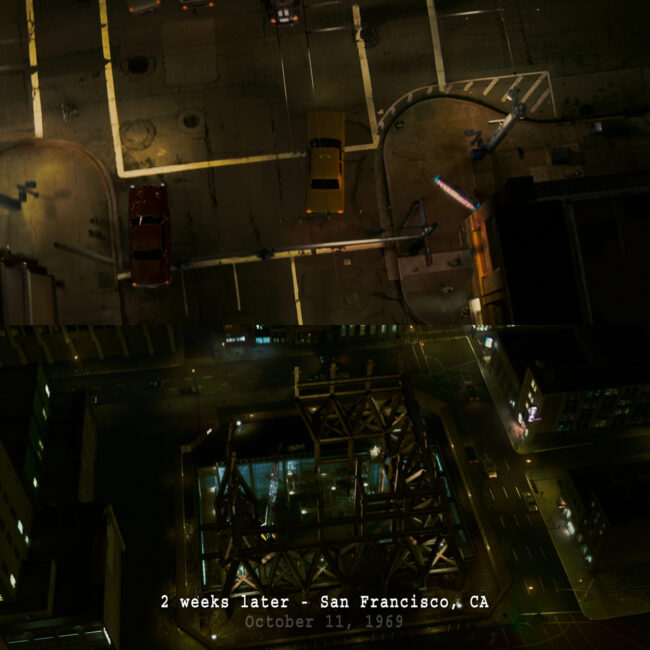Zodiac
Matte World Digital

Was gonna be a bad day
I had been working at a small architecture firm in Orinda, doing renders. It was an okay first job out of college, but my boss was dealing with some issues. He was trying, but one day he told me I should save my last paycheck because it might be a while before I got paid again. I panicked. Just a couple of hours later, one of my best friends called me and said, "Hey dude, want to work on a David Fincher movie... at Matte World Digital?" My answer was an enthusiastic "F@#k YES!"

Production
The first two shots I worked on were the opening scenes of the film. The first was an establishing shot of the HWY 37 bridge over Vallejo, where I was responsible for texturing, animating, lighting, and rendering the cars on the bridge, creating the fireworks, and texturing the bridge itself. These assets were then handed off to the Fusion artists. The second shot was a 27-second drive down a street in Vallejo, CA, where I had to add fireworks to the sky. The challenge was that the footage from the Thompson Viper camera was a bit grainy, and the color palette was muted. I had to painstakingly roto every house, tree, and chimney. Once that was done, I created the fireworks using stock footage and particle effects, then composited the shot for the final result—all while nursing a serious case of carpal tunnel.

Bigger and More
Next up was an extensive sequence, starting with a massive aerial shot of 1969 San Francisco. The camera peers down into the hole where the Transamerica Pyramid would eventually be built. Using 3ds Max, I created, lit, textured, and animated dozens of cars, pedestrians, and various environmental details like carts, benches, and garbage cans. It was those small touches that helped make the scene feel real rather than just another CG model. Then, Mike Breymann and I moved on to the next sequence, the famous taxi cab shot. This shot featured a unique "locked to camera" aerial movement. Only the taxi and the environment were CG, while we filmed stop-motion miniature vehicles, using cardboard boxes as makeshift buildings. We lit the scene with colored gels and positioned lights through holes in the boxes to create "light canyons." For pedestrians, we even filmed all the artists from above against a blue tarp. Once everything was prepared, I went back into the CG file to add a lot of digital set dressing to enhance the final shot.

matte Shot
I was given a really well-constructed Matte Painting, made by Brian Flora, and was told to give it a "still to life" treatment. Unfortunately, production got the date in the film wrong and we had to strip out all of the cars and replace with the appropriate era. Again this was mostly done with miniatures. I then added a mix of digital people, and animated digital plane from Morgan Trotter, and then a luggage hauler, some digital flags, and digital tree branches. After, I got to supervise my very first VFX shoot with the help of Ken Rogerson manning the Viper camera, and an old DV cam as well. We added people boarding planes, and wandering outside of Burbank airport.

This was my dream job,
I worked on a few more shots and it was mostly the same. Digital set dressing, digital people, creating assets and textures for many more. It should be known, that in 1996, I saw Se7en in the theater. And after watching the opening credits, I knew I needed to work in film...preferably on a Fincher flick. And as a kid reading Starlog, and Cinefex magazine. I knew I wanted to one day work for a place like Matte World Digital. Its is absolutely impossible to describe how it felt to do both things in one job.